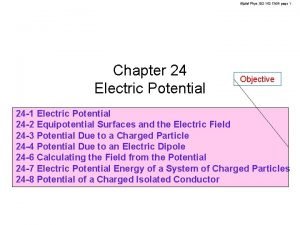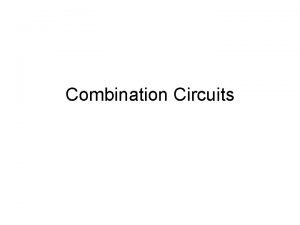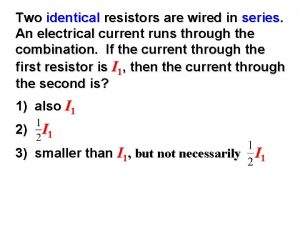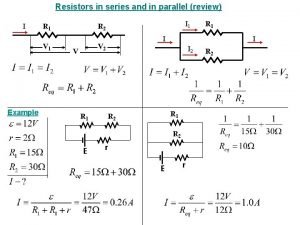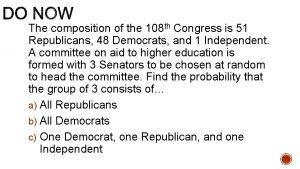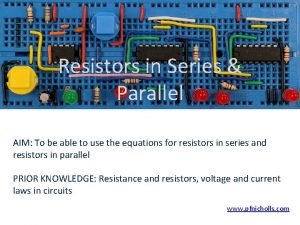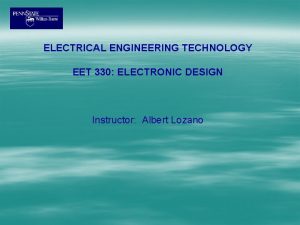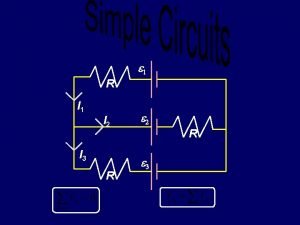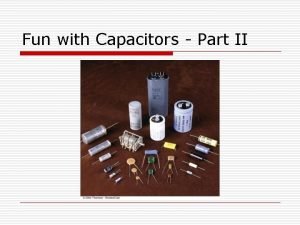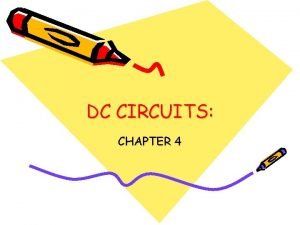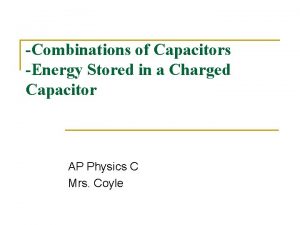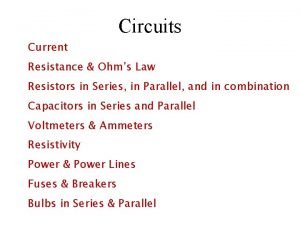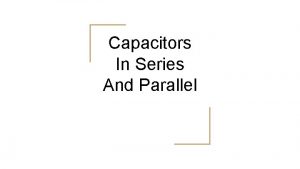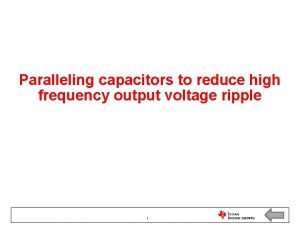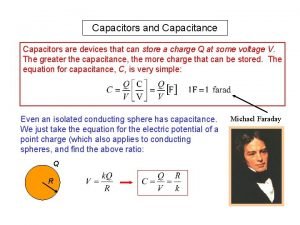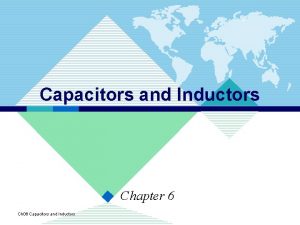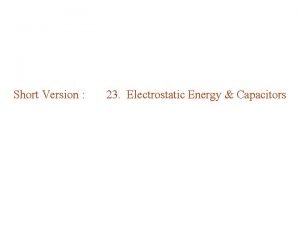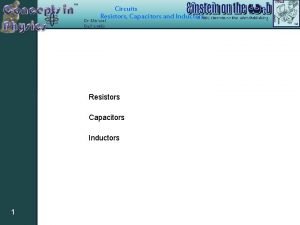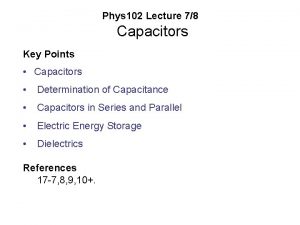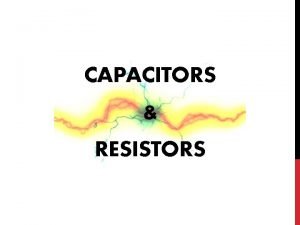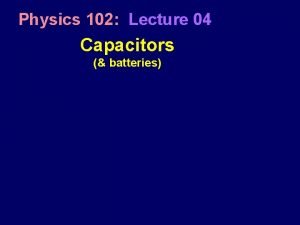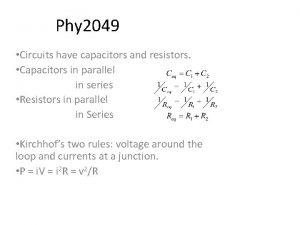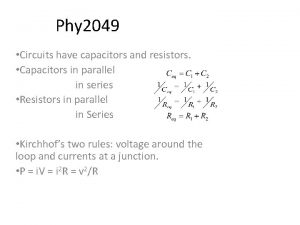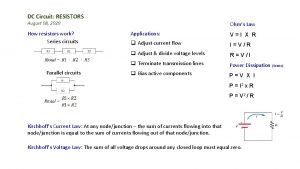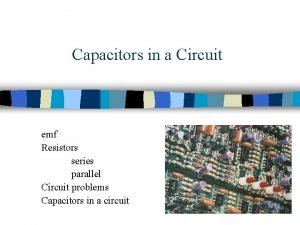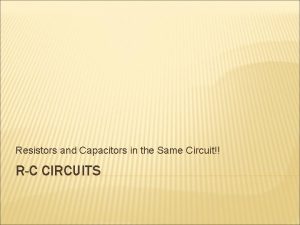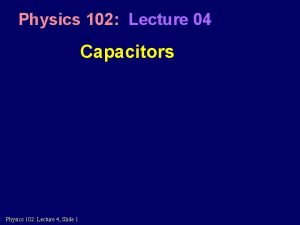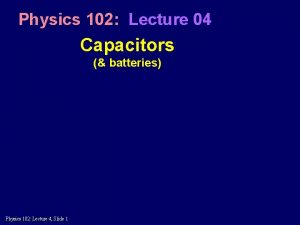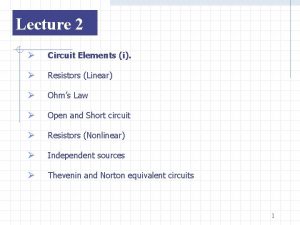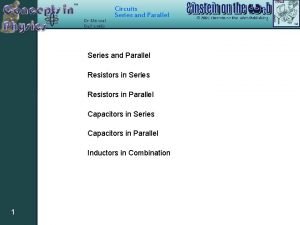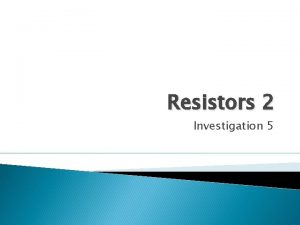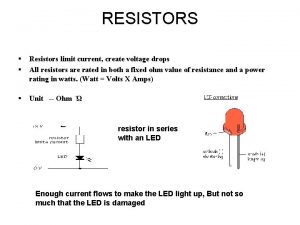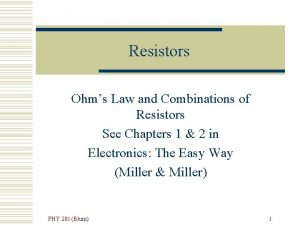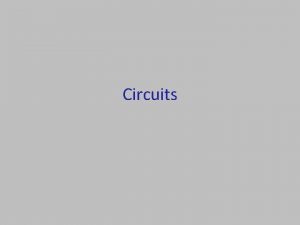Phys 102 Lecture 6 Circuit elements resistors capacitors





















- Slides: 21

Phys 102 – Lecture 6 Circuit elements: resistors, capacitors, and batteries 1

Today we will learn about. . . Circuit elements that: 1) 2) 3) 4) Serve as conduits for charge – wires Pump charges around – batteries Regulate flow of charge – resistors Store and release charge – capacitors These elements are idealizations of components in electronic circuits & in nature + + Ex: neurons, circulatory system Phys. 102, Lecture 6, Slide 2

Electric current Current – measure of flow of charge (+ charge, by convention) Counts total charge ΔQ passing through area in a time interval Δt Unit: A (“Amp” or “Ampere”) 1 A = 1 C/s + + I + + + Count charges through this area In electronic circuits, electrons (–e) carry current, flow opposite to current In liquid or gas, both cations and anions can carry current Phys. 102, Lecture 6, Slide 3

ACT: two light bulbs Two light bulbs 1 and 2 are connected end-to-end by conducting wire. If a current I 1 flows through bulb 1, what is the current I 2 in bulb 2? 1 . . . I 1 A. I 2 < I 1 B. I 2 = I 1 C. I 2 > I 1 2 . . . Phys. 102, Lecture 6, Slide 4

Batteries & electromotive force Battery – maintains a constant electric potential difference (“Electromotive force” – emf ε) I – + 9 V + Electric potential is 9 V higher at + end relative to – end. Potential difference across a circuit element is its “voltage” Electric potential difference drives current around circuit Battery does NOT determine how much current flows Battery does NOT generate new charges, it “pushes” charges, like a pump Phys. 102, Lecture 6, Slide 5

ACT: Two batteries Two 9 V batteries are connected end-to-end by conducting wire. What is the electric potential at point 2 relative to point 1? 1 2 – A. +18 V B. +9 V C. – 18 V D. – 9 V + – + Phys. 102, Lecture 6, Slide 6

Resistance and Ohm’s law Moving charges collide with each other, ions, defects inside material Flow rate depends on electric potential difference + VR I Double potential difference, double current DEMO Resistance – proportionality constant between current and voltage Ohm’s law: Units: Ω (“Ohms”) Potential difference causes current to flow (“downhill”, by convention) Resistance regulates the amount of flow Phys. 102, Lecture 6, Slide 7

Physical resistance Resistor – circuit element designed to have resistance Resistance depends on material parameters and geometry Resistivity – density of scatterers DEMO Material ρ (Ω∙m) Copper Iron Sea water Muscle Fat Pure water 1. 7 × 10– 8 9. 7 × 10– 8 0. 22 13 25 2. 4 × 105 Length – the longer the resistor, the more scattering Cross sectional area – the wider the resistor, the more charges flow Phys. 102, Lecture 6, Slide 8

ACT: Check. Point 1. 1 Which of the following three copper resistors has the lowest resistance? A. d B. 2 d C. d L/2 L R 1 L R 2 R 3 Phys. 102, Lecture 6, Slide 9

Power generated and dissipated Battery does work pumping charges through circuit Ex: a 9 V battery does 9 J of work per 1 C of charge pumped Power – rate of energy conversion Units: W (“Watts”) 1 W = 1 J/s = 1 V A Resistor dissipates electric potential energy Charges lose electric potential energy in collisions inside resistor Phys. 102, Lecture 6, Slide 10

Calculation: light bulb filament An incandescent light bulb is essentially a resistor that dissipates energy as heat and light. A typical light bulb dissipates 60 W with 120 V from an outlet. The resistive element is a thin (40 -μm diameter) filament of tungsten. How long must the filament be? Phys. 102, Lecture 6, Slide 11

Capacitance Capacitor – circuit element that stores separated charge Consists of two conductors separated by a small gap +Q –Q Capacitance – measures the ability to store charge Q given a voltage VC applied between the conductors Units: F (“Farad”) 1 F = 1 C/V Phys. 102, Lecture 6, Slide 12

Physical capacitance Parallel plate capacitor made up of two large conducting plates of area A separated by a small gap d + + + + + Electric field is uniform between plates (Recall Lect. 3) – – – d – – – A – – Field strength density of field lines density of charges Work to move +q from + to – plate in uniform E field (Recall Lect. 4) For a parallel plate capacitor: Capacitor voltage Capacitance depends on geometry Phys. 102, Lecture 6, Slide 13

ACT: Parallel plates A parallel plate capacitor carries a charge Q. The plates are then pulled a small distance further apart. + – + – What happens to the charge Q on each plate? A. Q increases B. Q stays constant C. Q decreases Phys. 102, Lecture 6, Slide 14

ACT: Parallel plates 2 A parallel plate capacitor carries a charge Q. The plates are then pulled a small distance further apart. + – + – DEMO The voltage VC between the plates A. Increases B. Stays the same C. Decreases Phys. 102, Lecture 6, Slide 15

Dielectrics Imagine placing insulating material (dielectric) between plates External field polarizes dielectric Excess +q and –q charges build up on opposite planes + Parallel planes of +q and –q create own E field, cancel out part of external E field + + – + + + – – – + + + Dielectric constant κ > 1 – – + – – (Recall Lect. 3 – conductors) Phys. 102, Lecture 6, Slide 16

Dielectric constant κ measures how much a material is polarized by electric field Since , need less E (or V) to store same Q, so C = Q/V increases: Dielectric constant Capacitance with dielectric Material κ (> 1) Vacuum Air Rubber Glass Cell membrane Pure water 1 (exactly) 1. 00054 3 -4 5 7 -9 80 Capacitance without dielectric Capacitance depends on material parameters (dielectric) and geometry Phys. 102, Lecture 6, Slide 17

Calculation: capacitance of a cell Channels in a cell’s membrane create a charge imbalance (recall Lect. 5), with + charge outside, – inside. The separated charge gives the cell capacitance, with the membrane acting as a dielectric (κ = 7). Based on EXAM 1, FA 09 Voutside = 0 +Q = 6 nm Vinside = – 70 m. V κ=7 –Q What is the capacitance of a 1 -μm 2 flat patch of cell? At rest, a cell has a – 70 m. V voltage across it. How much charge is necessary to generate this voltage? Phys. 102, Lecture 6, Slide 18

Capacitor energy Separated charges have potential energy (Recall Lect. 4) Important factor of ½! Don’t confuse this equation with U = q. V for individual charge q Why separate charge? Defibrillator Camera flash A way to store and release energy Lightning strike Phys. 102, Lecture 6, Slide 19

ACT: Capacitor dielectric A parallel plate capacitor carries a charge Q. A dielectric with κ > 1 is inserted between the plates. + – + + κ>1 – – What happens to energy UC stored in the capacitor? A. UC increases B. UC stays constant C. UC decreases Phys. 102, Lecture 6, Slide 20

Summary of today’s lecture • Batteries generate emf ε, pump charges • Resistors dissipate energy as power: P = IV Resistance: how difficult it is for charges to get through: R = ρL/A Voltage determines current: V = IR Ideal wires have R = 0, V = 0 • Capacitors store energy as separated charge: U = ½QV Capacitance: ability to store separated charge: C = κε 0 A/d Voltage determines charge: V = Q/C • Don’t mix capacitor and resistor equations! Phys. 102, Lecture 6, Slide 21
 Physics 102 uiuc
Physics 102 uiuc Aljalal phys 102
Aljalal phys 102 Aljalal phys 102
Aljalal phys 102 Basic electricity and optics
Basic electricity and optics 01:640:244 lecture notes - lecture 15: plat, idah, farad
01:640:244 lecture notes - lecture 15: plat, idah, farad Simplifying resistors
Simplifying resistors Identical resistance
Identical resistance Resistors in series and parallel
Resistors in series and parallel A package contains 12 resistors 3 of which are defective
A package contains 12 resistors 3 of which are defective Resistors in series and parallel equations
Resistors in series and parallel equations Ceramic composition resistors
Ceramic composition resistors Walmart resistors
Walmart resistors Two cylindrical resistors are made from the same material
Two cylindrical resistors are made from the same material Fun with capacitors
Fun with capacitors Dc
Dc Energy stored in parallel plate capacitor
Energy stored in parallel plate capacitor What is ohm's law solved for current? i = v/r v= i/r r= i/v
What is ohm's law solved for current? i = v/r v= i/r r= i/v Charge in series and parallel
Charge in series and parallel Paralleling capacitors
Paralleling capacitors Difference between capacitor and capacitance
Difference between capacitor and capacitance Capacitors and inductors
Capacitors and inductors C=q/v
C=q/v

